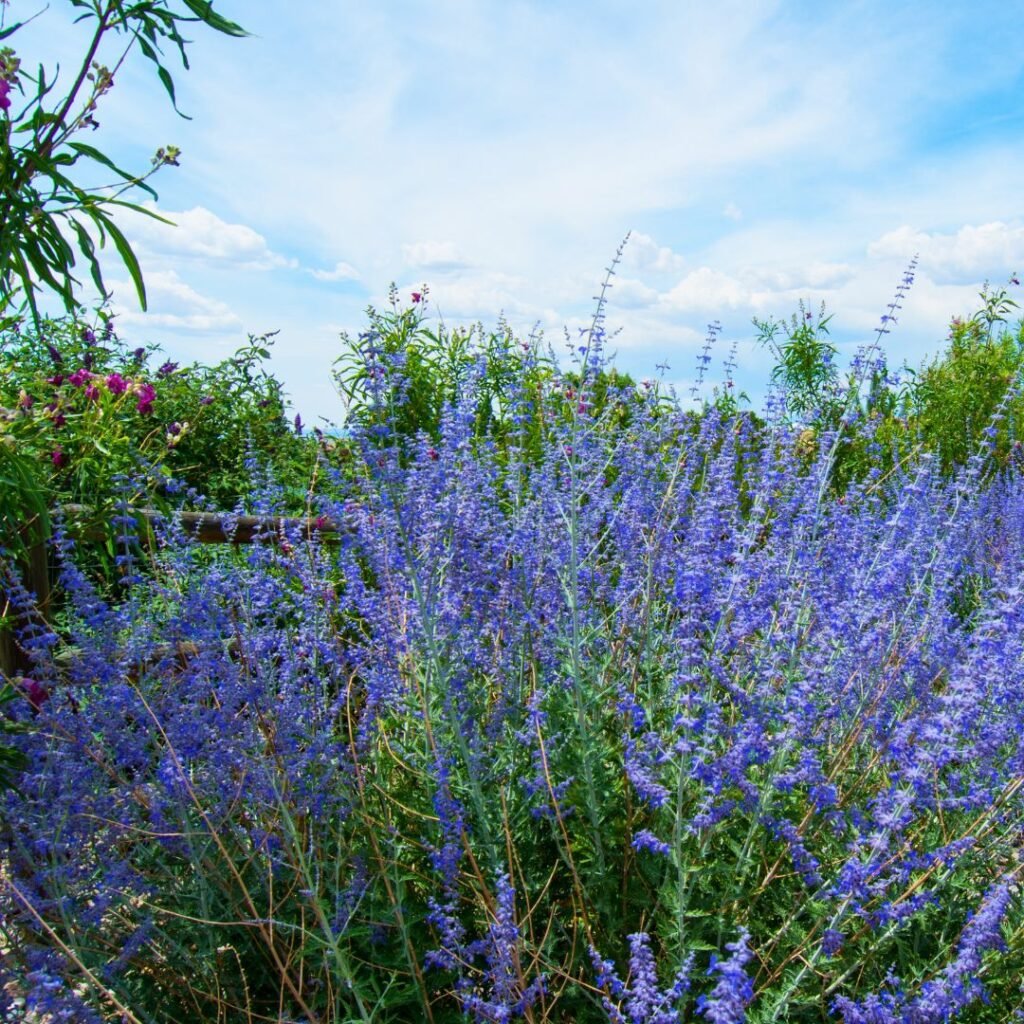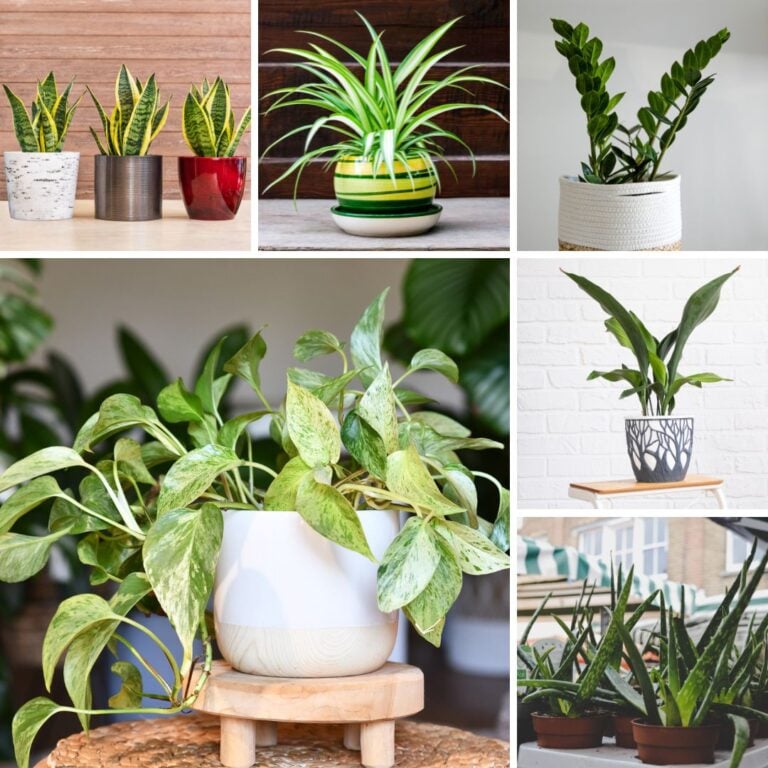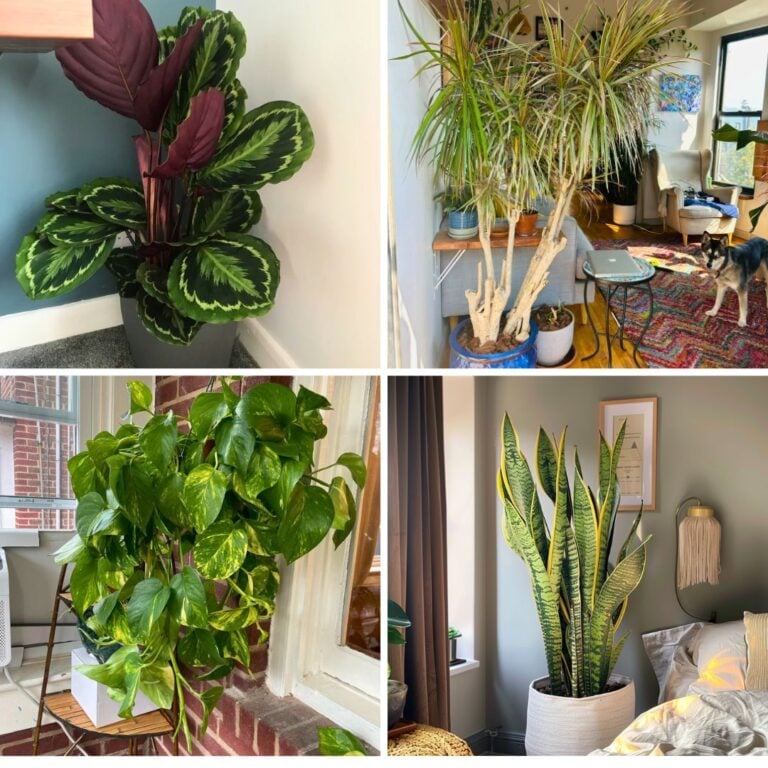15 Tall Perennial Flowers You Must Grow This Year!
There’s just something about tall perennial flowers—they can totally transform a garden in an instant.
Their height brings structure, splashes of color, and a sense of movement that just draws your eye.
Any space feels more alive with them around. Tall perennials make a strong visual impact, and you don’t have to replant them every single year.
I’m excited to share some of my favorite tall varieties that really bring both height and beauty to a garden.
If you’re looking for simple design ideas or care tips, I’ve got you covered so your flowers can thrive for years.
Please note: Simplify Plants is reader-supported. As an Amazon Associate, I earn from qualifying purchases made by our readers with no extra cost added to you all! Some links in the post are affiliate links and I get a commission from purchases made through links in the post.
1) Delphinium

Delphiniums are one of those plants that just make a garden pop. Their tall flower spikes are real showstoppers, and the colors—blue, purple, pink, white—mix so well with other summer blooms.
I always pick a sunny spot with rich, well-drained soil when planting them. Regular watering is key, especially if it’s dry out, but soggy roots are a no-go. I stake them early since the tall stems can flop over in the wind.
They usually bloom in early to mid-summer. If I remember to cut back the first blooms, I sometimes get a second, smaller flush later on. That little bonus color is always welcome.
Delphiniums aren’t fans of hot, humid weather. They thrive in cooler places and come back strong each year. A bit of compost or organic fertilizer in spring seems to help them reach their full height.
I like putting them at the back of beds or along fences, where they create a natural backdrop for shorter plants. Plus, bees and butterflies love them, so the garden feels extra lively.
Cutting a few stems for a vase? They last several days and look amazing, but the stems are pretty delicate—handle with care.
Sure, they take a little extra effort, but honestly, the vibrant blooms and elegant look make Delphiniums one of my top tall perennials.
2) Joe Pye Weed

Joe Pye Weed is just fantastic for adding height and color to the garden. It can shoot up to 5 or even 7 feet, and those clusters of pinkish-purple blooms in late summer are hard to miss. Butterflies and bees can’t stay away.
I usually tuck it into full sun or partial shade, wherever the soil stays moist but drains well. It likes to spread out, so I give it plenty of space. Once it’s settled in, there’s not much to do besides watering during dry spells.
The sturdy stems rarely need staking, which is nice. Even after the flowers fade, the plant keeps its shape through fall, and the dried seed heads look kind of cool in winter.
I like pairing Joe Pye Weed with coneflowers, black-eyed Susans, or ornamental grasses. The mix of textures and colors just works. It’s also a great background plant for shorter perennials.
Cut flowers from this plant last several days indoors and add a gentle, sweet scent to the room. Trimming old blooms helps keep things tidy and encourages a bit of fresh growth.
If you want height, color, and wildlife with almost no fuss, Joe Pye Weed is a winner. It’s one of those dependable, low-maintenance plants that fits right in, whether your garden is wild or more put-together.
3) Russian Sage

Russian Sage is one of those plants that brings a soft, airy vibe to the garden. The tall stems and silvery leaves really pop against all the green. And the tiny lavender-blue flowers bloom from mid-summer into fall, so you get color for ages.
It can get up to 4 feet tall, which adds height without making things feel crowded. I like putting it near shorter flowers for a layered effect. Plus, its open shape lets more sunlight reach the plants around it.
Russian Sage loves full sun and well-drained soil. Wet roots? Not its thing. I let the soil dry out between waterings, and once it’s established, it handles drought like a champ.
Bees and butterflies visit all the time, which keeps the garden buzzing. And since deer don’t seem interested, I never have to worry about them munching it.
Every late winter, I cut the stems back to about a foot tall. That way, new growth comes in strong each spring. The silvery foliage looks good even before the flowers show up, adding some texture early on.
I love mixing Russian Sage with Black-Eyed Susans or Coneflowers—the yellow and purple together just pop. It also blends nicely with ornamental grasses for a more natural, breezy look.
If you need to fill space, Russian Sage is a good pick. It spreads slowly and steadily, so just give it some room.
Honestly, every year I’m glad I planted it. Russian Sage brings height, light, and a calm beauty that works in almost any garden.
4) Bee Balm

Bee Balm is one of those plants that just lights up my garden every summer. The bright blooms—red, pink, purple, or white—stand tall in clusters and really draw the eye.
It’s part of the mint family, so there’s a fresh, herbal scent when you brush past. I sometimes toss the leaves in tea for a little extra flavor.
Bee Balm is a magnet for bees, butterflies, and hummingbirds. Watching hummingbirds dart around the flowers is honestly a highlight of the season.
I find it grows best in full sun and moist, well-drained soil. It can handle some shade, but the more sun, the better the blooms. I keep it watered during dry spells.
Most varieties reach 3 to 4 feet tall, so I plant it in the middle or back of my beds to let the height shine without crowding out smaller plants.
Bee Balm can spread fast through underground stems. To keep things under control, I divide the clumps every few years. It’s a nice way to share extra plants with friends, too.
One thing to watch for is powdery mildew, especially if it’s humid. I space plants out for better airflow and water the soil, not the leaves.
With its bold color, easy care, and pollinator appeal, Bee Balm has definitely earned a spot in my lineup. It brings beauty and energy to the garden, year after year.
5) Hollyhock

Hollyhocks are just classic for adding height and color. These tall beauties can shoot up six to eight feet, making a bold statement along fences or walls. The big, round blooms come in so many shades—pink, red, yellow, white, purple.
I always plant them in full sun since they love plenty of light. Well-drained soil is a must, and I water them regularly, especially if it’s hot and dry. Once they’re established, they’re surprisingly tough.
They bloom in mid to late summer and draw in bees, butterflies, and hummingbirds. The garden feels more alive with all that activity.
Hollyhocks are usually biennials or short-lived perennials, so they often flower in their second year. I let some flowers go to seed so they can pop up again next season.
To keep them neat, I snip off faded blooms and support the tall stalks with stakes if they start to lean. Good air flow helps prevent rust, which can be a hassle with these guys.
I love planting them at the back of borders or next to fences, where their height really stands out. They’re perfect for cottage-style gardens and look great with other tall flowers like delphiniums or foxgloves.
Even though they’re simple, Hollyhocks make a big impression. Their tall stalks and cheerful blooms always bring a smile and brighten up the whole garden.
6) Foxglove

Foxglove is one of those plants that instantly adds drama and height. The tall spikes covered in bell-shaped blooms are hard to ignore. With colors like pink, purple, white, and yellow, they fit into almost any garden mix.
I usually plant Foxglove in partial shade, where it gets some morning sun but a break from the afternoon heat. Moist, well-drained soil is best, and I make sure to keep up with watering during dry spells.
Each stem can reach up to five feet, so it’s perfect for filling vertical space. I like putting Foxglove at the back of flower beds for that layered look. The tall stems also make beautiful cut flowers for inside.
Foxglove is a biennial, so it grows leaves the first year and flowers the second. I let some plants self-seed to keep new ones coming up each year. It’s an easy way to keep the garden full.
A quick note—every part of Foxglove is toxic if eaten. I always wear gloves when handling it and keep it away from pets and kids. Still, it’s one of my favorites for its classic, easy-going beauty.
Bees seem to love Foxglove, and I often spot them buzzing in and out of the flowers. Supporting pollinators while enjoying pretty blooms? Win-win.
Once the flowers fade, I either trim the stems for a fresh look or let them go to seed. Foxglove brings that classic cottage garden vibe that never really gets old.
7) Liatris

Liatris—sometimes called blazing star or gayfeather—brings such cool vertical interest to the garden. The tall, spiky blooms stand out against shorter plants and always catch the eye.
It does best in full sun and well-drained soil. I’ve noticed it’s pretty tough, handling heat and drought without much fuss.
Flowers show up in mid to late summer, opening from the top of the spike downward. The purple or pink blooms are butterfly and bee magnets, adding movement and energy.
I usually plant Liatris in groups for more impact. Tall stems look great at the back of beds or along fences, showing off their height.
After blooming, I leave the seed heads standing through fall for extra texture and as food for birds. It keeps things interesting even when the flowers are done.
Liatris also makes fantastic cut flowers. The long stems last for days in a vase and hold up really well.
Since it’s low-maintenance and hardy, I always recommend Liatris to anyone wanting a tall, reliable perennial that keeps looking good year after year.
8) Cardinal Flower

I really love how the Cardinal Flower pops in the garden with those bold red blooms. It’s a native North American plant, and honestly, I think it’s one of the best for attracting hummingbirds and butterflies.
Whenever I spot those flashes of red, I know my garden’s buzzing with life. This flower prefers moist soil and a bit of shade, so I usually tuck it near a pond or along a damp, shady border.
It’s not a fan of dry spells, so I try to remember to give it extra water if summer gets too hot. The tall spikes can shoot up to four feet, which gives my flower beds some nice vertical drama.
Each stem has clusters of tube-shaped flowers that open from the bottom up. The blooms stick around from mid to late summer, adding color just when other plants start to fizzle out.
The Cardinal Flower is a short-lived perennial, but it tends to reseed itself if I let some flowers go to seed. That way, I get new plants popping up the next year without much fuss.
Since it’s native, this flower supports local wildlife. Hummingbirds seem to go wild for it, and bees stop by too. There’s something satisfying about knowing my garden helps pollinators and still looks gorgeous.
If I’m going for a bold look, I’ll plant Cardinal Flowers in clusters of three or five. It just looks better than a single plant, and the deep red pairs really well with white or purple flowers nearby.
Cutting back spent blooms helps keep things neat and sometimes encourages more growth. With a bit of care, these flowers pay me back with color and lively visitors every summer.
9) Garden Phlox

I have to say, Garden Phlox brings so much height and color to my summer garden. The tall stems and big clusters of blooms make it hard to miss, even when it’s surrounded by shorter plants.
It’s one of those perennials I can count on—it comes back every year and doesn’t ask for much. The flowers show up in pink, purple, white, and red, and they’re a magnet for butterflies and hummingbirds.
I like planting them in groups to really fill out the color. The scent is gentle but nice, especially in the evenings when the air cools down a bit.
Phlox likes full sun and moist, well-drained soil. I try to leave some space between plants for good air flow, which helps keep mildew away.
When the blooms are done, I cut back the stems to tidy up and encourage new growth. Every few years, I’ll divide the clumps so they don’t get too crowded.
Garden Phlox usually grows 2 to 4 feet tall, which makes it perfect for the middle or back of a bed. I like mixing it with coneflowers or black-eyed Susans for some contrast.
Since it’s a long-blooming perennial, my garden stays colorful from midsummer into early fall. The stems are sturdy, so wind and rain don’t bother them much.
For me, Garden Phlox is a no-brainer if I want easy color and a garden that feels alive all season.
10) Blazing Star

There’s something about Blazing Star that just works in my garden. Those tall, upright spikes with tiny purple or white flowers look tidy and add real texture, even from across the yard.
It’s also called Liatris, and it blooms in mid to late summer. I like how the flowers open from the top down—it’s a little different from most other perennials.
The blooms pull in butterflies, bees, and hummingbirds, so there’s always some action going on. Blazing Star likes full sun and well-drained soil.
Once it’s settled in, it handles dry spells better than a lot of other tall flowers, so I don’t have to fuss over watering. I usually plant them in groups for a fuller look.
The narrow leaves and tall shape make it easy to pair with coneflowers or black-eyed Susans. The flower spikes are awesome as cut flowers—they last a long time in a vase and keep their color.
In the fall, I let the seed heads stay. They add interest in winter and the birds appreciate the snack.
Blazing Star is one of those low-maintenance plants that looks fancy but doesn’t ask for much. I don’t need to stake it, and pests pretty much leave it alone.
11) Tall Coneflower

I’m always impressed by how Tall Coneflowers rise above the rest of my garden. The sturdy stems and bright petals seem to catch the light just right, drawing attention without being too showy.
They bring height and color that stick around for most of the summer. Depending on the variety, these flowers can reach up to five feet tall.
I plant them in full sun, making sure they get at least six hours of light. Once they’re settled in, they handle heat and dry spells like champs.
The blooms show up in pink, purple, yellow, and white, each with that classic raised center cone. Bees and butterflies love them, so there’s always a bit of movement around.
They do best in well-drained soil, so I avoid heavy clay or soggy spots. A bit of compost in spring helps keep them strong.
When the flowers fade, I leave the seed heads for fall and winter. They look cool sticking up out of the snow and birds snack on the seeds.
I’ll cut a few for fresh bouquets—they last ages in a vase. The rest stay put to keep the pollinators happy.
Each spring, I trim old stems before new growth shows up. They spread slowly, so every few years I divide them to keep things healthy.
If you want a low-maintenance flower that still makes a statement, Tall Coneflower is hard to beat.
12) Gladiolus

There’s just something about Gladiolus—the way it brings height and color to my garden is hard to match. These flowers can reach up to four feet, giving a strong vertical accent that stands out.
I plant the corms in spring after the last frost, usually in full sun and well-drained soil. I make sure to space them out so each plant has room.
Each spike is loaded with trumpet-shaped flowers that open from the bottom up. It’s fun watching the colors unfold over a few weeks.
You’ll find blooms in pink, red, yellow, white, and purple. To stretch out the bloom time, I stagger planting new corms every couple of weeks.
That way, I get fresh flowers for most of summer. I also cut a few spikes for vases—they last surprisingly well indoors.
After the flowers are done, I let the leaves hang around until they turn yellow. This helps the corms store up energy for next year.
In colder spots, I dig them up before frost and store them somewhere cool and dry. Gladiolus always adds a tall, elegant touch—whether it’s mixed with other perennials or lined up in rows, it’s a real eye-catcher.
13) Yellow Loosestrife

I’m a fan of how Yellow Loosestrife brightens up my garden with its tall stems and sunny yellow blooms. It usually grows 2 to 4 feet tall, which is just right for borders or spots near ponds.
This perennial does best in moist soil and full to partial sun. I’ve noticed it thrives in areas that stay damp after rain.
The plants spread slowly by underground stems, so I keep an eye out to prevent them from taking over. The flowers bloom in mid to late summer, forming cheerful clusters along the stems.
Bees and butterflies seem to love them, which keeps the garden lively. I like pairing Yellow Loosestrife with other moisture-loving plants like irises or hostas.
The yellow flowers against green foliage just looks happy. To keep things neat, I snip off spent blooms and trim back any stems that get out of hand.
If I need to control spreading, I’ll divide the clumps every few years. It’s also a nice excuse to share extra plants with friends.
Yellow Loosestrife is a solid choice if you want a tall, colorful perennial that handles wet spots and adds a warm glow to the garden.
14) False Indigo

I really like how False Indigo brings height and color without much fuss. This perennial grows in tall clumps with sturdy stems that don’t flop, even on windy days.
Its tidy shape works in both formal and laid-back gardens. In late spring, I look forward to spikes of blue or purple flowers rising above the foliage.
The blooms remind me of sweet peas and stick around for weeks. When they fade, the plant forms decorative seed pods that stay interesting all summer and fall.
I plant False Indigo in full sun and well-drained soil. Once it’s established, I barely have to water it, and pests don’t seem interested.
It can reach 3 to 4 feet tall, so I usually put it near the back of a border. The blue flowers look great next to yellow or white blooms, and the gray-green leaves stay fresh-looking.
False Indigo grows slowly and doesn’t like being moved, so I pick the spot carefully. Its deep roots help it weather dry spells, and it just gets bigger and better every year.
When I want a tall, reliable perennial with real staying power, False Indigo is one of my top picks. It adds structure and color from spring through fall.
15) Giant Hyssop

Giant Hyssop brings a nice mix of color and height to my garden. It grows tall and upright, often reaching 3 to 5 feet, so it stands out even among other big plants.
The spikes of small flowers pull in bees, butterflies, and hummingbirds all summer. The blooms come in purple, pink, blue, or white, depending on the type.
I like how the colors stay vivid in full sun, and the flowers have a light, minty scent that makes the garden feel fresh. Giant Hyssop does best in well-drained soil and full sun.
I try not to overwater since it prefers things on the drier side. Once it’s established, it handles heat and drought without much trouble.
I plant it near fences or at the back of beds for height. It looks great with coneflowers, black-eyed Susans, or ornamental grasses—the mix of textures is nice.
In late fall, I cut the stems back to tidy up, and it comes back strong every spring. I also appreciate that it’s deer-resistant—one less thing to worry about.
For anyone wanting a low-maintenance perennial that helps pollinators, Giant Hyssop is a smart pick. It adds color and life with hardly any work.
Design Tips for Showcasing Tall Perennial Flowers
Tall perennials really do add height, texture, and color to a garden. I focus on how they fit in with the space and how they play off shorter plants to keep things balanced and easy on the eyes.
Creating Vertical Interest in Garden Beds
I love using tall perennials to create layers of height that naturally draw your eyes up. Plants like delphiniums, hollyhocks, and Joe Pye weed are perfect for the back of borders or tucked along fences and walls—they won’t steal sunlight from your shorter favorites.
To keep things from looking, well, flat, I like to mix in plants with different shapes and textures. It just makes everything pop a bit more.
| Height | Plant Type | Example |
|---|---|---|
| Tall | Spiky | Liatris |
| Medium | Rounded | Coneflower |
| Short | Ground cover | Creeping phlox |
I also try to stagger bloom times so there’s always something colorful from spring right through fall. That way, you never end up with a sad-looking gap.
Pairing Tall Perennials With Shorter Plants
Pairing tall flowers with medium and low-growing plants really fills out a garden bed and gives it balance. Shorter plants like coreopsis, salvia, or hostas help soften the base of those tall stems and cover up any bare patches.
Grouping by color and texture is a trick I use a lot. Tall purple delphiniums with low yellow daylilies? That combo stands out every time.
I’ll often repeat small clusters of the same tall plant across the bed. It keeps things looking intentional, not random.
To make life easier, I try to stick with plants that share similar water and sun needs. Less fuss, more happy flowers.
Caring for Tall Perennial Flowers
Keeping tall perennials healthy isn’t too complicated, but they do need the right support and steady care. Strong stems and balanced feeding go a long way toward upright growth and longer blooms.
Supporting Tall Stems
I use stakes, cages, or trellises to help tall flowers stay upright—wind can really do a number on them otherwise. Supports go in early, before things get wild, so I’m not disturbing roots later.
When tying stems, I reach for soft twine or garden tape and always leave a bit of wiggle room. Tight ties? Not a good idea—they can cut into stems.
For cluster growers like delphiniums or hollyhocks, a circular plant support just works better. Air moves through, and nothing flops over.
Sometimes I’ll trim or pinch back the tops of tall perennials in early summer. It encourages them to grow stronger and bushier, so I’m not chasing after falling stems all season.
Watering and Fertilizing Tips
I water my tall perennials deeply once or twice a week, depending on how hot and dry it gets. Shallow watering just doesn’t cut it—roots need to go deep.
I check the soil about 2 inches down; if it’s dry, it’s time for a drink.
Spreading 2–3 inches of mulch around the base helps hold in moisture and keeps weeds down. Plus, the roots stay cool, which they seem to love.
For feeding, I go with a balanced fertilizer (10-10-10) in early spring and again after the first big bloom. Too much nitrogen? Nope, that just makes them floppy, so I use it sparingly.
If leaves start yellowing or growth slows, I’ll add compost or organic matter to boost the soil. Good soil really does make a difference for tall, colorful blooms.
Frequently Asked Questions
People ask me all the time about growing tall perennial flowers that add color and height to a garden. Honestly, it comes down to the right care, sunlight, and picking plants that will thrive where you live.
What are some popular tall perennial flowers for adding height to my garden?
I’m a fan of Delphinium, Joe Pye Weed, and Hollyhock because they get nice and tall, giving that vertical punch. Russian Sage is another good one, with silvery leaves and lavender-blue blooms that stick around all summer.
How do I care for tall perennial flowers to ensure they thrive year after year?
I make sure to water deeply (but not too often) so roots grow strong. I also cut back old stems after blooming, and a layer of mulch helps keep moisture in. Those steps really help plants come back healthy each year.
Can you recommend any tall perennials that are also drought-resistant?
Russian Sage is a top pick for dry spots—it’s tough and doesn’t mind poor soil. Bee Balm is pretty resilient too, especially once it’s settled in and you mulch around the base.
What are the best tall perennials for creating a backyard privacy screen?
I like Joe Pye Weed and Hollyhock for a living privacy screen. They get tall, fill in thick, and give you summer color and a bit of seclusion.
Which tall perennials should I choose for a garden that gets little sunlight?
For shadier spots, Joe Pye Weed does fine with partial sun. Bee Balm can handle less light too, though it’ll bloom best if it gets a few hours of morning sun.
Are there any tall perennial flowers that attract pollinators like bees and butterflies?
Bee Balm and Joe Pye Weed are two of my favorites for this. Bees and butterflies can’t seem to resist their blooms.
If you’re hoping to support pollinators all season, these are honestly great choices. Their nectar-rich flowers really do the trick.
Recommended Garden Supplies
| Product Image | Our Recommended Gardening Supplies | Check Offers! |
|---|---|---|
Top Top
Top
Top
Top
Top
Top
Top
Top | rePotme Houseplant and Tropical Classic Potting Soil Mix | Check Offer On Amazon |
 Top
Top
Top
Top
Top
Top
Top
Top | Espoma Organic Indoor Plant Food | Check Offer On Amazon |
 Top
Top
Top
Top
Top
Top
Top
Top | GooingTop LED Grow Light 6000K Full Spectrum Clip Plant Growing Lamp | Check Offer On Amazon |
 Top
Top
Top
Top
Top
Top
Top
Top | Soil Moisture Meter | Check Offer On Amazon |
 Top
Top
Top
Top
Top
Top
Top
Top | Govee Hygrometer Thermometer, Bluetooth Enabled! | Check Offer On Amazon |
 Top
Top | LEVOIT Humidifiers for Large Room(Best For Plants) | Check Offer On Amazon |
 Top
Top
Top
Top
Top
Top
Top
Top | Upgraded DIY Automatic Drip Irrigation Kit, 15 Potted Houseplants Support | Check Offer On Amazon |
 Top
Top
Top
Top
Top
Top
Top
Top | Stainless Steel Heavy Duty Gardening Tool Set | Check Offer On Amazon |
 Top
Top
Top
Top
Top
Top
Top
Top | Bonide Insecticidal Soap | Check Offer On Amazon |
 Top
Top
Top
Top
Top
Top
Top
Top | Bonide 32 oz Spray Neem Oil for Organic Gardening | Check Offer On Amazon |
 Top
Top
Top
Top
Top
Top
Top
Top | Garden Safe Fungicide | Check Offer On Amazon |
Note: Some images in the articles are sourced from Reddit and Other Platforms For Reference Purpose.






